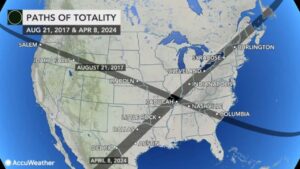UPCOMING ECLIPSE WONT BE NEARLY AS AWESOME FOR US AS 2017
Tennessee Tech Astronomy Professor Steve Robinson said the Upper Cumberland will not get a great view of Monday’s partial eclipse.
Robinson said this eclipse will be a far cry from the one that left many awestruck in 2017. He said though 92 percent of the sun will be blocked out, Tennesseans may only notice the sky grow slightly dimmer for a moment, if it is a clear day.
“No comparison whatsoever as far as the total eclipse goes,” Robinson said. “We’ll see a partial eclipse and if you’ve got the special eclipse glasses and if you look up at the sun, and of course you’ve got to have those glasses on to look at the sun, you look up the sun, you’ll see the sun gradually getting blocked out by the moon.” As you can see in the graphic the 2017 shadow passed pretty much directly over Crossville. The upcoming eclipse shadow will pass beyond the west Tennessee border.
Robinson said for those who wish to travel to the path of totality and get the best view of the astrological phenomenon, Indiana is likely the closest place with a good view. He said many humans never get to see even a partial eclipse, so the trip might be worth taking for a good look.
“The fact that you can experience one is amazing,” Robinson said. “And it truly is an awesome experience in the true sense of the word to see the sun disappear for a few minutes in the sky in the middle of the day. It’s just pretty amazing, and all of the sensations that go with that.”
He said the air will cool for a few minutes without the heat of the sun and animals will begin to behave strangely because they are made to think night is approaching due to the sun’s momentary absence. He said the path of totality will only be about 100-150 miles wide, traveling from Mexico, through Texas, Arkansas, and Indiana up to New England and Canada.
“From a scientific point of view, it’s interesting because it allows us an opportunity to study the very inner part of the atmosphere of the sun called the corona,” Robinson said. “Normally during the day, we can’t see that because the sun, itself, is way too bright.”
He said the phenomenon is caused by the earth, moon, and the sun forming a straight line as the moon revolves. Robinson said these happen roughly once a year, but typically take place in inhospitable environments like the Arctic or the middle of the ocean. He said scientists are now able to track these hundreds of years in advance.




